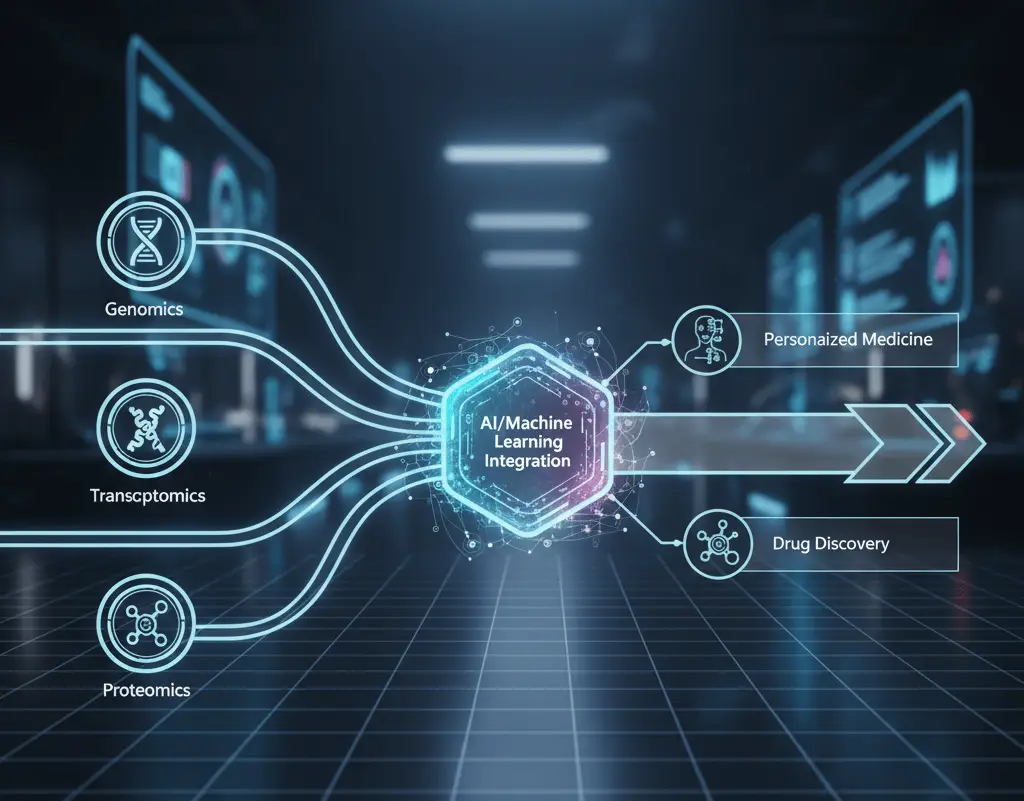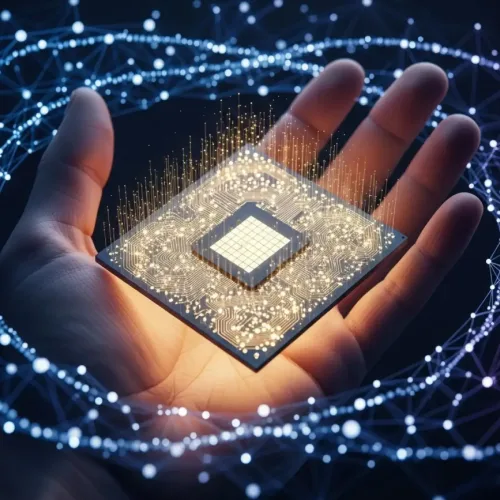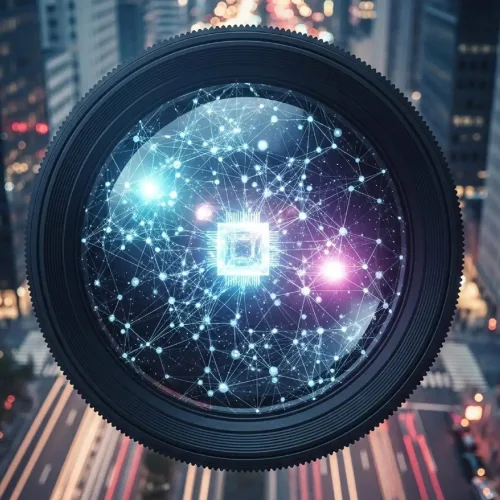If you were asked to conduct a detailed study of a city, but all you had was a blurry image provided by a satellite, what would you do? Of course, you will be able to see the overall structure and buildings, but it will be quite difficult for you to get detailed information about this city. You will have to face the difficulty of knowing how the people living in this city live, what is their lifestyle, and what are the relationships between them. In other words, it will be quite difficult for you to know the details of this city. This is precisely the same challenge that single-cell multi-omics is finally solving in biology.
For many years, scientists studied biology using large-scale sequencing, which analyzed the average molecular structure of millions of cells all at once. This traditional approach gave us data that looked like the “average city,” but it hid important differences between individual cells.
Every organ in our body, from the brain to the liver, is built from many different kinds of cells, much like an orchestra filled with unique instruments. Traditional bulk sequencing could only capture the entire performance at once, mixing the sounds of violins, trumpets, and drums into one tune. If a single trumpet played a wrong note, it would be lost in the noise. In the same way, rare but vital cells, like early cancer cells or stem cells, often went unnoticed.
To truly understand biology, scientists needed to change their approach. They had to look closer at studying each cell on its own and exploring everything happening inside it at once. That’s exactly what led to the rise of single-cell multi-omics, a groundbreaking leap in molecular biology and medicine. Let’s explore how this technology works and why it’s transforming our understanding of life itself.
What is Single-Cell Multi-Omics?
Imagine a cell as a busy factory. The DNA acts as the master plan, RNA carries working copies of the instructions, proteins serve as the machines that get the jobs done, and metabolites are the raw materials and finished products. In the past, scientists could study only one of these layers at a time, and usually by mixing data from millions of cells together.
Now, single-cell multi-omics changes that concept completely. This advanced technique allows researchers to capture several molecular layers, like genomics, transcriptomics, proteomics, and epigenomics, from the same individual cell. Instead of studying cells in bulk, scientists can now explore each cell on its own while tracking multiple “omics” layers at once.
Let’s make this concept more simple by this example: imagine you’re trying to figure out how a restaurant works. You could talk to all the employees at once and get a general idea, that’s like a bulk analysis. But if you follow each worker individually, the chef, the server, and the dishwasher, you’d see exactly what each one is doing. You’d notice what they’re reading (like RNA), what tools they’re using (proteins), and what ingredients they’re handling (metabolites), all at the same time. That’s what single-cell multi-omics does.
This technology helps researchers to explore questions that were once out of reach. They can now find out which cells in a tumor resist chemotherapy, how stem cells choose their specific roles, and why some brain cells are more prone to Alzheimer’s disease. With single-cell multi-omics, scientists can finally see the molecular details behind these complex mysteries.
The Science Behind the Working of Single-Cell Multi-Omics
Single-cell multi-omics involves several coordinated steps, each step is designed to preserve the cell’s molecular integrity while collecting comprehensive data.
Step 1: Isolating Individual Cells
Scientists start by physically separating cells using techniques such as microfluidics, fluorescence-activated cell sorting (FACS), or droplet-based systems. Each cell is then encapsulated and tagged with unique barcodes. These barcodes act like ID tags, ensuring that all data from one cell stays linked together during analysis.
Step 2: Capturing Multiple Omic Layers
Once isolated, scientists extract multiple types of biological information:
- DNA (to study mutations and methylation)
- RNA (to measure active gene expression)
- Proteins (to monitor signaling and function)
- Chromatin (to study gene regulation and accessibility)

Step 3: Sequencing and Profiling
Advanced sequencers analyze genetic and molecular tags, producing huge amounts of raw data. This data reveals which genes are active (gene expression) and which sections of DNA are open and ready to be read.
Step 4: Computational Integration and Data Analysis
This is where the real magic of omics integration begins. Scientists use powerful bioinformatics tools and machine learning models to bring together different datasets, like RNA, DNA modification, and protein data, from the same cell. By combining them, they can clearly see how these molecular layers interact and influence one another.
The Power of Multi-Omics
The power to analyze and combine data from individual cells isn’t just a technological breakthrough, it is completely transforming how we understand medicine and biology. Instead of relying on broad assumptions, science can now study each cell directly and uncover what’s truly happening inside.
Understanding Cancer Cell Evolution
As we all know, Cancer is not a single disease, it’s a group of rebellious cells that keep evolving, adapting, and fighting back against treatment. When doctors study a tumor in bulk, they miss this hidden variety among the cells. But with single-cell multi-omics, researchers can now see the full picture, every unique state and behavior of cancer cells within a tumor.
This powerful method helps scientists spot rare, treatment-resistant cells before therapy even begins. They can also watch how tumors change when exposed to drugs and map the exact molecular patterns of cells that spread to other parts of the body. By understanding each cell’s profile, doctors can design personalized cancer treatments that target the real troublemakers in your tumor, not just the average cancer cell.
For example, single-cell studies have revealed that some tumor cells slow down and slip into a dormant state, becoming invisible to chemotherapy. These hidden cells survive treatment and can trigger a relapse months or even years later. By finding their unique molecular signature, researchers can now explore new ways to stop cancer from coming back.
Mapping Brain Cell Diversity
Our brain has about 86 billion neurons, and each one isn’t the same. Different types of neurons use different neurotransmitters, connect to unique targets, and perform specific roles. In the past, scientists could only classify neurons into broad categories. But now, with single-cell multi-omics, they can identify hundreds of distinct cell types and subtypes.
This detailed map of brain cell diversity is transforming neuroscience. Researchers can now explore exactly which cell types die in Alzheimer’s disease, which neurons get damaged first in Parkinson’s, and why certain cells are more sensitive to depression or anxiety.
Studying this variety also helps us understand how the brain develops. Scientists can now track how neural stem cells mature and discover the molecular signals that decide whether a cell becomes a neuron, an astrocyte, or an oligodendrocyte. This insight could one day lead to regenerative treatments for brain injuries and neurodegenerative diseases.
Early Disease Detection and Biomarkers
Many diseases start quietly with small changes in certain groups of cells. By the time symptoms show up, much of the damage is already done. Single-cell multi-omics helps catch diseases early by spotting abnormal cells before they spread problems across tissues.
In autoimmune disorders, scientists use this approach to study immune cells and see which ones mistakenly attack the body’s own tissues. In diabetes, they can look closely at pancreatic beta cells to find out when and why these cells begin to fail. For heart disease, they can track stressed heart cells before the heart’s performance starts to drop.
This kind of early, cell-level diagnosis gives doctors a chance to step in sooner. Detecting disease before it harms an organ could completely transform how we prevent and treat illnesses.
Major Techniques Used in Single-Cell Multi-Omics
Scientists have developed several advanced techniques to study different layers of molecules within single cells. Each technique comes with its own strengths, limits, and best uses. By understanding these methods, we can better appreciate how flexible and powerful single-cell multi-omics truly is.
| Technique | Omics Combined | Typical Application |
|---|---|---|
| CITE-seq | RNA + Proteins | Immune profiling, signaling studies |
| scNMT-seq | DNA methylation + RNA + Chromatin | Epigenetic regulation research |
| SNARE-seq | Chromatin + Transcriptome | Linking gene activity with accessibility |
| Paired-seq | RNA + Chromatin + Protein | Comprehensive cellular mapping |
These tools provide flexibility, researchers choose the combination based on the biological question they’re asking.
Key Challenges in Single-Cell Multi-Omics Research
Single-cell multi-omics holds incredible potential, but researchers and data scientists still face major challenges that they need to overcome to make it widely usable.
Data Complexity and Computational Load
A single-cell multi-omics experiment can produce terabytes of data. Scientists must bring that data together and analyze many kinds of information, like genetic sequences, protein levels, and epigenetic marks. Doing this takes advanced bioinformatics tools and strong computing systems. The hardest part is integrating all these data types accurately, since each comes from a different layer of the same single cell. Researchers are still developing new algorithms to make this process smoother. However, the demand for massive computing power and specialized software continues to be a major hurdle in single-cell research.
Cost and Reproducibility
These advanced technologies cost a lot, so only well-funded labs can usually afford to use them. On top of that, working with single cells is naturally tricky. Even tiny differences in how the experiment is done can cause inconsistent results. Scientists must constantly make sure that the data from each cell truly represents its real state, and not just an error or damage during the process.
Cell Damage and Technical Limitations
When scientists isolate and break open a single cell, the process itself can stress or damage it, changing its natural molecular state before any measurement happens. To overcome this, researchers keep improving their techniques to capture the cell’s real molecular profile as it exists inside the body. Detecting very small amounts of certain molecules, like rare proteins or metabolites, adds another challenge. Because these molecules exist in such tiny quantities, they’re often missed during analysis, causing data gaps or “dropouts.”
Analogy Suggestion:
It’s like trying to record every note in an orchestra—with one tiny, perfect mic per instrument—without scaring the musician or damaging the instrument. And then you have to perfectly sync all the recordings!
Future of Single-Cell Multi-Omics
The future of single-cell multi-omics looks incredibly bright. New technologies and innovative methods are quickly solving today’s challenges and unlocking exciting new possibilities for discovery.
1. AI and Machine Learning Integration
Artificial intelligence is reshaping the way scientists study multi-omics data. With machine learning, researchers can now automatically detect different cell types, predict how cells will behave, and uncover hidden patterns that humans might miss.
Deep learning models trained on millions of cells can spot disease signatures, forecast treatment outcomes, and suggest new ideas about how cells function. As these AI systems keep learning from growing datasets and past studies, they become even smarter and more reliable.
Natural language processing (NLP) now helps scientists read and understand research papers alongside lab data, linking molecular profiles with existing scientific knowledge. Meanwhile, computer vision connects microscopy images to molecular data, showing how a cell’s structure relates to its molecular state.

AI and single-cell multi-omics work together in a powerful feedback loop. As data improves, AI models become smarter. And as those models get better, they uncover even deeper insights from the data. This teamwork speeds up discoveries—not just step by step, but at an exponential pace.
If you’re curious about how AI is reshaping biology, Deep Learning for the Life Sciences is a great place to start. It clearly explains how machine learning is transforming the way we study and understand life.
2. Real-Time Cell Profiling
Most current techniques study preserved or fixed cells, just snapshots of a single moment. But new technologies are changing that by allowing real-time tracking of living cells. Imagine being able to see how a cell’s molecular profile shifts as it reacts to a drug or transforms into another cell type.
With microfluidic chambers, scientists can now keep cells alive while sampling their molecular state again and again. Non-destructive imaging tools make it possible to measure protein levels without harming the cells. When paired with computational models, these methods can follow single cells through dynamic events like immune responses or cancer growth.
Real-time profiling could completely transform drug testing. Instead of relying on one final measurement, researchers could actually watch how cells change over hours or even days. This makes it possible to find the perfect treatment timing and dosage. By adding this time-based layer, scientists gain a richer understanding, building on the spatial and molecular details already known.
3. Democratization and Accessibility
As technology keeps evolving, it’s becoming cheaper, easier to use, and more accessible. Today, commercial platforms let researchers perform single-cell analysis with just a few clicks. Cloud-based tools remove the need for high-end computers, while online learning resources help more scientists master these methods.
This growing accessibility means single-cell multi-omics is no longer limited to big research institutes, it’s now within reach for smaller labs, hospitals, and even university classrooms. As more people use it, discoveries will happen faster, and diverse perspectives will guide how the technology grows and applies to real-world challenges.
The future of single-cell multi-omics goes far beyond basic research. It marks a major shift in how we study life, from studying cell populations to exploring individual cells, from single data points to connected layers of information, and from fixed moments to ongoing biological processes. This evolution will reshape medicine, paving the way for healthcare that’s truly personalized, preventive, and precise.
Recap: Why It’s a Big Deal
The rise of single-cell multi-omics marks one of the biggest breakthroughs in molecular biology since the Human Genome Project. It’s changing how we understand health and disease—moving us from vague, population-wide averages to clear, individual insights.
By studying a cell’s DNA (its blueprint), RNA (its messages), and proteins (its actions) all at once, scientists can now uncover what truly defines each cell and what goes wrong when disease appears.
At Learning Breeze, we’re passionate about making these groundbreaking ideas easy for everyone to grasp. Single-cell multi-omics isn’t just another lab technique, it’s a new way of seeing life, one that opens the door to genuinely personalized medicine.
Every cell has its own story, and through multi-omics, we can finally hear them all. Ready to put your learning to the test? Try our interactive Cell Biology Quiz and discover how much you truly know!
Recommended Reads for Curious Minds
To explore this topic further, here are some trusted resources available on Amazon:
- Single-Cell Omics: Volume 2: Technological Advances and Applications by Dr. Debmalya Barh
- Practical Computing for Biologists by Steven H. D. Haddock
- Molecular Biology: Principles of Genome Function by Nancy L. Craig
- The Emperor of All Maladies: A Biography of Cancer by Siddhartha Mukherjee
Frequently Asked Questions about Single-Cell Multi-Omics
Bulk sequencing measures the average molecular activity (like gene expression) across thousands or millions of cells mixed together, which can hide unique cell populations. Single-cell multi-omics analyzes multiple molecular layers (transcriptomics, proteomics, epigenomics) from one cell at a time. This allows researchers to detect cell heterogeneity and study rare cell types, which is impossible with the bulk method.
The primary layers typically include:
1. Transcriptomics (RNA, or gene expression): What messages the cell is currently following.
2. Epigenomics (DNA methylation and chromatin accessibility): What parts of the DNA are “open” or “closed” for use.
3. Proteomics (Proteins): The functional molecules carrying out the cell’s tasks.
4. Genomics (DNA mutations): The underlying blueprint of the cell.
Single-cell multi-omics is crucial for precision medicine because it profiles a patient’s specific, diseased cells (like cancer or immune cells) at an individual level. By obtaining a complete molecular profiling of these cells, doctors can predict which treatments will be most effective for that patient, moving away from “one-size-fits-all” drug choices.
CITE-seq (Cellular Indexing of Transcriptomes and Epitopes by Sequencing) is one of the important multi-omics techniques. It allows researchers to simultaneously measure two critical layers from the same single cell: the transcriptome (all the RNA) and the abundance of key surface proteins (proteomics).
References
- Macaulay, I. C., & Voet, T. (2023). Single-cell multi-omics: multiple measurements from single cells. Nature Reviews Genetics, 24(2), 85–98.
- Stuart, T., & Satija, R. (2022). Integrative single-cell analysis. Cell Reports, 40(3), 111045.
- Hu, Y., An, Q., Sheu, K., Trejo, B., & Fan, J. (2023). Challenges and opportunities in single-cell multi-omics data integration. Genome Biology, 24(1), 211.
- Argelaguet, R., et al. (2022). Computational methods for single-cell multi-omics integration. Nature Biotechnology, 40(7), 1098–1110.
- Chen, G., Ning, B., & Shi, T. (2023). Artificial intelligence in single-cell analysis. Science Advances, 9(1), eadc0456.
- Svensson, V., da Veiga Beltrame, E., & Pachter, L. (2024). Advances in multi-omics data integration: from bulk to single-cell. Nature Reviews Genetics, 25(5), 377–392.
- Kim, J., & Han, S. (2024). Emerging trends in single-cell multi-omics technologies. Trends in Biotechnology, 42(4), 550–563.
- Regev, A., et al. (2023). The Human Cell Atlas and the future of cellular biology. Nature, 622(7989), 500–512.
- Li, X., Wang, C., & Zhang, W. (2023). Machine learning applications in single-cell transcriptomics. Frontiers in Genetics, 14, 1152034.
- Liu, Y., et al. (2024). Ethical and practical considerations in single-cell multi-omics. Nature Methods, 21(6), 612–624.




